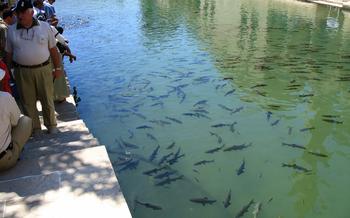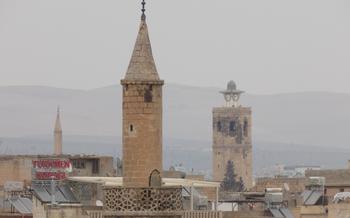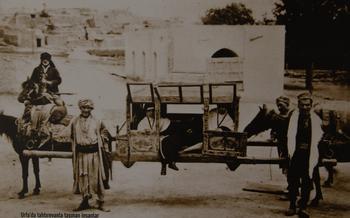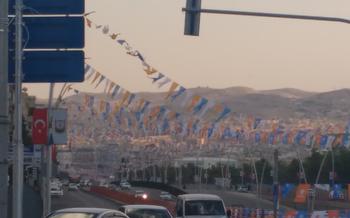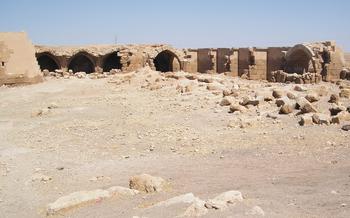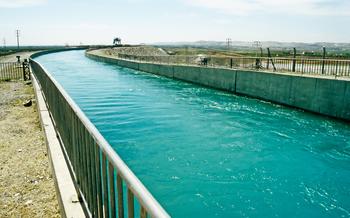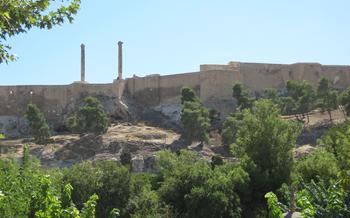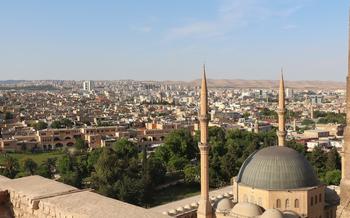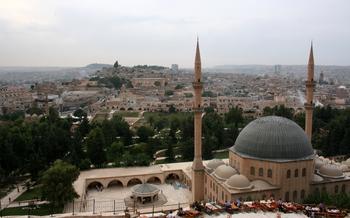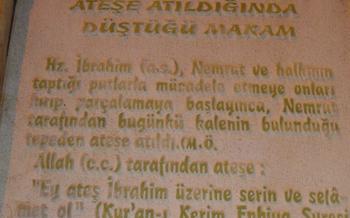
Abraham's Cave (İbrahim’in Mağarası)
- The Cave of Patriarchs
- Biblical and Historical Context
- Cave Explorations
- Religious Symbolism
- Cultural Heritage
- Architecture and Design
- Views and Surroundings
- Visitor Amenities
- Local Cuisine and Delicacies
- Accommodation Options
- Transportation and Accessibility
- Safety and Security
- Etiquette and Customs
- Planning Your Visit
- Insider Tip
The Cave of Patriarchs
The Cave of Patriarchs, also known as Abraham's Cave (İbrahim’in Mağarası), holds immense religious and historical significance in Şanlıurfa, Turkey. According to various faiths, the cave is believed to be the birthplace of the prophet Ibrahim (Abraham), the revered patriarch of Judaism, Christianity, and Islam. This profound connection has made the cave a sacred pilgrimage site for centuries, attracting countless visitors seeking spiritual and cultural enrichment.
The cave's interior is adorned with intricate carvings and inscriptions, each narrating a chapter in the rich history of the region. Its walls bear witness to the passing of time, with ancient artifacts and relics providing tangible links to the past. Visitors can wander through the cave's chambers, experiencing a palpable sense of reverence and wonder as they retrace the footsteps of one of the world's most revered religious figures.
Practical Information:
Location: The Cave of Patriarchs is situated in the historic city center of Şanlıurfa, Turkey. Hours: The cave is open to visitors daily, with hours varying depending on the season. Admission: Admission fees are minimal and contribute to the preservation and maintenance of the site.
Biblical and Historical Context
The Cave of Patriarchs holds immense significance in various religions, notably in Judaism, Christianity, and Islam. According to biblical accounts, the cave served as a sanctuary for the prophet Abraham during his journey from Mesopotamia to Canaan. It is believed that Abraham sought refuge in the cave with his family and followers, seeking divine guidance and protection. The cave's association with Abraham has made it a revered site for religious pilgrims and believers who trace their lineage to the patriarch.
The cave also holds prophetic significance in various religions. In the Islamic tradition, the cave is known as "Makam Ibrahim," and it is believed to be the place where Abraham received divine revelations and instructions. In the Christian tradition, the cave is associated with the visit of the three wise men who followed the star of Bethlehem to pay homage to the infant Jesus.
Archaeological excavations in the vicinity of the cave have unearthed ancient artifacts and remains that provide glimpses into the historical significance of the site. These discoveries have helped to corroborate the biblical accounts and shed light on the cave's role as a place of worship and refuge throughout history.
Cave Explorations
The Cave of Patriarchs presents a fascinating and awe-inspiring journey through its intricate interior. Upon entering, visitors are greeted by an impressive natural rock formation known as the "Praying Stone," said to resemble a figure in prayer. The cave's layout consists of several chambers and passages, each holding its own unique charm and significance.
One of the highlights of the cave is the "Abraham's Chamber," believed to be the place where the prophet Abraham resided during his stay in Şanlıurfa. This chamber exudes a sense of tranquility and reverence, inviting visitors to contemplate the profound spiritual connection associated with this sacred site.
Throughout the cave, visitors can observe remarkable geological formations, including stalactites and stalagmites that have formed over thousands of years, creating captivating patterns and shapes. These natural wonders add an artistic dimension to the cave's interior, making each visit a visually stunning experience.
For those seeking a deeper understanding, guided tours are available, providing insightful commentary on the cave's history, religious significance, and unique geological features. Alternatively, visitors can opt for self-exploration, allowing them to immerse themselves in the cave's tranquil atmosphere at their own pace.
To enhance your cave exploration, remember to wear comfortable shoes as the terrain can be uneven. Additionally, bring a flashlight or headlamp to illuminate the darker corners of the cave and capture the intricate details of the rock formations.
Religious Symbolism
The Cave of Abraham holds immense sacredness and reverence across multiple faiths, attracting pilgrims and visitors from around the world. In Islam, it is believed that the cave served as a sanctuary for the prophet Abraham (Ibrahim) and his family during their journey from Ur to Canaan. Muslims regard the cave as a holy site and often visit it to pay homage to the prophet and seek blessings.
For Christians, the cave is associated with the patriarchs and matriarchs of the Old Testament, including Abraham, Isaac, and Jacob. It is believed that these biblical figures resided in the cave during their time in the region. The cave's significance extends to the Jewish faith as well, as it is mentioned in the Torah as the place where Abraham offered sacrifices to God.
Pilgrims from various religions visit the cave to experience its spiritual aura and connect with their religious heritage. Many participate in prayers, meditations, and other devotional practices within the cave's hallowed chambers. The cave has become a place of pilgrimage and spiritual retreat, where visitors seek solace, guidance, and a deeper connection with their faith.
Cultural Heritage
The Cave of Abraham is deeply embedded in the cultural heritage of Şanlıurfa, Turkey, and the surrounding region. Local traditions and customs associated with the cave have been passed down through generations, shaping the unique identity of the site. Folklore, legends, and myths surrounding the cave add to its mystique and significance. The cave is a focal point for cultural events and festivals, attracting visitors from near and far to celebrate its rich history and cultural heritage. Preservation efforts and initiatives are underway to protect and maintain this sacred site for future generations, ensuring that its cultural value and significance endure.
Architecture and Design
The Cave of Abraham stands as a testament to the ingenuity and craftsmanship of ancient builders. Its unique architecture blends seamlessly with the surrounding landscape, creating a harmonious coexistence between nature and human creation. The cave's intricate carvings and inscriptions offer a glimpse into the artistic and cultural heritage of the region.
The cave's interior features a series of chambers and tunnels, each with its own distinct character. The main chamber, known as the "Grand Hall," is adorned with intricate carvings and inscriptions that depict scenes from the life of Abraham and other biblical figures. The walls are adorned with vibrant colors and patterns, creating a sense of awe and wonder.
The cave also boasts a number of smaller chambers, each with its own unique features. One chamber, known as the "Chamber of Miracles," is said to have been the site where Abraham performed many of his miracles. Another chamber, known as the "Chamber of Reflections," is a place of quiet contemplation and meditation.
The Cave of Abraham has undergone extensive restoration and conservation efforts in recent years, ensuring its preservation for future generations. These efforts have focused on preserving the cave's original features while also improving accessibility and safety for visitors.
The cave's unique architecture and design have earned it recognition as a UNESCO World Heritage Site. It is considered a masterpiece of Islamic architecture and a testament to the enduring legacy of the region's rich cultural and historical heritage.
Views and Surroundings
The Abraham's Cave is nestled amidst a breathtaking landscape that complements its spiritual significance. As you emerge from the cave, you'll be greeted by panoramic views of the surrounding hills and valleys, offering a sense of tranquility and connection with nature. The cave's location provides a unique vantage point to witness the changing colors of the sky during sunrise and sunset, creating a magical ambiance.
In the vicinity of the cave, you'll find several other notable landmarks and attractions that are worth exploring. Take a leisurely walk to the nearby Balikli Gol (Fish Lake), a sacred pool revered for its numerous carp and turtles. According to local belief, these fish are considered to be blessed and bring good fortune to those who feed them. Along the way, you'll encounter friendly locals who are always willing to share stories and insights about the cave's history and significance.
For those who enjoy outdoor activities, the area surrounding the cave offers ample opportunities for hiking, nature walks, and exploration. Embark on a scenic trail that leads you through lush forests, past cascading waterfalls, and up to panoramic viewpoints. Whether you're an experienced hiker or simply seeking a leisurely stroll, there's a trail suitable for every level of fitness and interest.
Don't forget to capture the stunning beauty of your surroundings with your camera. The breathtaking views, coupled with the cave's unique architecture, provide ample opportunities for capturing memorable photographs. Embrace your creativity and experiment with different angles and perspectives to create lasting memories of your visit to the Abraham's Cave.
Visitor Amenities
At Abraham's Cave, visitors can take advantage of various facilities and services to enhance their experience. The site offers well-maintained restrooms, ensuring the comfort and convenience of all visitors. Wheelchair accessibility is also provided, enabling individuals with mobility challenges to navigate the cave with ease.
For those seeking a deeper understanding of the cave's significance, guided tours are available in multiple languages, including English, Arabic, and Turkish. These tours provide insightful commentary and historical context, enriching the visitor's experience. Knowledgeable and experienced guides lead these tours, ensuring a comprehensive and engaging exploration of the cave.
To capture the essence of the cave and its surroundings, visitors are welcome to bring their cameras and take photographs. However, it's essential to be mindful of the sacred nature of the site and respect the privacy of other visitors.
For those who prefer a self-guided exploration, brochures and maps are available, providing detailed information and directions. These resources allow visitors to explore the cave at their own pace, immersing themselves in its beauty and tranquility.
Local Cuisine and Delicacies
The Şanlıurfa region is renowned for its rich culinary traditions, offering a diverse array of flavors and dishes that tantalize the taste buds. When visiting the Abraham's Cave, take the opportunity to indulge in the local cuisine and savor the unique culinary delights that the area has to offer.
For an authentic Turkish breakfast experience, try the traditional menemen, a flavorful dish of scrambled eggs with tomatoes, peppers, and spices. Accompany it with freshly baked pide bread or gözleme, a savory flatbread filled with various ingredients like cheese, spinach, or minced meat.
For lunch or dinner, explore the local restaurants and sample Şanlıurfa's signature dishes. The lahmacun, a thin and crispy flatbread topped with minced lamb, tomatoes, and herbs, is a must-try. Another local delicacy is çiğ köfte, a spicy dish made from raw minced meat, bulgur, and various spices.
For a sweet treat, indulge in the famous künefe, a crispy shredded pastry filled with melted cheese and soaked in sweet syrup. Şanlıurfa is also known for its delicious baklava, a flaky pastry filled with chopped nuts and sweetened with syrup.
To fully immerse yourself in the local culinary experience, visit the vibrant local markets, where you can find fresh produce, spices, and traditional sweets. You can also purchase Şanlıurfa's famous isot pepper, a unique and flavorful spice that adds a fiery kick to dishes.
Whether you choose to dine at a local restaurant or savor the flavors of street food, the Şanlıurfa region offers a culinary journey that will delight your palate and leave you craving for more.
Accommodation Options
When planning your stay in Şanlıurfa, you'll find a range of accommodation options to suit different budgets and preferences. From budget-friendly guesthouses to luxurious hotels, there's something for every traveler.
For those seeking a budget-friendly option, there are several guesthouses and hostels within walking distance of the cave. These offer basic but comfortable accommodations at affordable prices. Some popular choices include the Urfa Hostel and the Abraham's Cave Guesthouse.
If you prefer a more upscale experience, there are several hotels in the city center that offer modern amenities and convenient access to the cave. The Hilton Garden Inn Şanlıurfa and the Divan Şanlıurfa are two highly-rated options that provide a comfortable and luxurious stay.
For a unique and memorable experience, consider staying in one of the traditional cave hotels in the city. These hotels offer a glimpse into the region's rich history and culture, with rooms carved directly into the rock formations. The Gamirasu Cave Hotel and the Elif Cave Hotel are two popular choices that offer a truly unforgettable stay.
No matter your budget or preferences, you're sure to find the perfect accommodation in Şanlıurfa to make your visit to Abraham's Cave and the surrounding area a memorable one.
Transportation and Accessibility
Getting to the Cave of Patriarchs in Şanlıurfa is relatively straightforward, with various transportation options available to suit different preferences and budgets.
- Public Transportation:
- Local buses and minibuses offer affordable and convenient transportation to the cave from Şanlıurfa city center.
- Look for buses or minibuses bound for "İbrahim'in Mağarası" or "Halil-ür Rahman."
-
The journey takes approximately 30-45 minutes.
-
Renting a Car:
- For those seeking flexibility and independence, renting a car is a great option.
- Several car rental companies operate in Şanlıurfa, and prices vary depending on the type of vehicle and rental duration.
-
The drive to the cave takes about 30 minutes, and ample parking is available at the site.
-
Private Driver or Guided Tour:
- For a hassle-free experience, consider hiring a private driver or booking a guided tour.
- Many local tour operators offer guided excursions to the cave, often combined with visits to other nearby attractions.
-
This option provides the convenience of pre-arranged transportation and the expertise of a knowledgeable guide.
-
Tips for Navigating Local Transportation:
- Learn a few basic Turkish phrases for essential communication, such as directions or asking for assistance.
- Be prepared for some language barriers, as English proficiency may be limited outside of major tourist areas.
- Keep small change handy for bus or minibus fares, as exact change is often required.
Safety and Security
Visiting Turkey, and particularly the Abraham's Cave, is generally safe for travelers. However, it's essential to be aware of your surroundings and take necessary precautions to ensure a safe and enjoyable experience. Here are some safety tips to keep in mind:
- General Safety Tips:
- Be cautious of pickpockets and petty theft, especially in crowded areas.
- Avoid walking alone at night, particularly in isolated areas.
- Keep your valuables secure and don't flaunt expensive items.
-
Be respectful of local customs and traditions, and dress modestly when visiting religious sites.
-
Specific Safety Considerations for Visiting the Cave:
- The cave can be uneven and slippery, so wear comfortable shoes with good traction.
- Use a flashlight or headlamp to navigate the cave's darker areas.
- Be aware of your surroundings and watch your step to avoid tripping or falling.
-
Respect the sanctity of the cave and avoid any actions that may be considered disrespectful or disruptive.
-
Local Customs and Etiquette:
- Remember that Turkey is a Muslim country, and it's important to be respectful of local customs and religious practices.
- Dress modestly and avoid wearing revealing clothing, especially when visiting religious sites.
-
Be mindful of your behavior and avoid engaging in any activities that may be considered offensive or disrespectful.
-
Emergency Contacts and Resources:
- Keep the emergency contact numbers of your embassy or consulate handy in case of an emergency.
- Familiarize yourself with the local emergency services numbers, which are 112 for police, 110 for fire, and 118 for medical assistance.
Etiquette and Customs
When visiting the Abraham's Cave, it is essential to be mindful of local customs and religious sensitivities. Dress modestly and respectfully, covering your shoulders and knees. Avoid wearing revealing or excessively tight clothing. Be mindful of your behavior and tone of voice, maintaining a respectful and solemn demeanor.
Photography and videography are generally permitted, but it is crucial to be discreet and avoid using flash or causing disturbances to other visitors. Always ask for permission before photographing or filming individuals, especially if they are engaged in prayer or religious rituals.
When interacting with locals and fellow visitors, be friendly and respectful. Greet people with a smile and a nod, and use polite language. Be open to learning about local customs and traditions, and avoid engaging in discussions that may be considered offensive or disrespectful.
By observing these simple guidelines, you can ensure a pleasant and enriching experience for yourself and those around you, fostering a sense of mutual understanding and respect.
Planning Your Visit
To make the most of your visit to Abraham's Cave, careful planning is essential. The best time to visit is during the shoulder seasons (April-May and September-October) when the weather is pleasant and the crowds are smaller. If you're interested in a more spiritual experience, consider visiting during Ramadan or another religious holiday.
For a comprehensive experience, allocate at least half a day to explore the cave and its surroundings. Combine your visit with other nearby attractions such as the Göbekli Tepe archaeological site, the Harran ruins, or the Şanlıurfa Museum to gain a deeper understanding of the region's rich history and culture.
Pack comfortable shoes for walking on uneven surfaces, as well as a hat, sunscreen, and water to stay hydrated during your explorations. A camera is a must to capture the stunning scenery and intricate details of the cave.
To delve deeper into the history and significance of the site, consider hiring a local guide who can provide insights and anecdotes that bring the stories of Abraham and other prophets to life. They can also assist with translation and help you navigate the cultural nuances of the region.
Insider Tip
-
Secret spots and hidden gems: Venture off the beaten path to discover hidden gems like the nearby Harran, an ancient city with unique beehive-shaped houses. Explore the Siverek Castle, a magnificent fortress with stunning views of the surrounding landscape.
-
Local festivals and events: Time your visit to coincide with local festivals and events, such as the annual Abraham Festival, which celebrates the patriarch's legacy with cultural performances and religious ceremonies.
-
Unusual or off-the-beaten-path activities: For an unforgettable experience, take a hot air balloon ride over the mesmerizing Cappadocia region, known for its unique rock formations and stunning views. Embark on a thrilling ATV adventure through the scenic valleys and hills surrounding Şanlıurfa.
-
Tips for getting the most out of your visit: Engage with the friendly locals, who are renowned for their hospitality and warmth. Learn a few basic Turkish phrases to connect with them and gain insights into their culture. Savor the flavors of local cuisine by trying traditional dishes like çiğ köfte, a spicy raw meatball dish, and şıllık, a delicious pastry filled with cheese and herbs.
